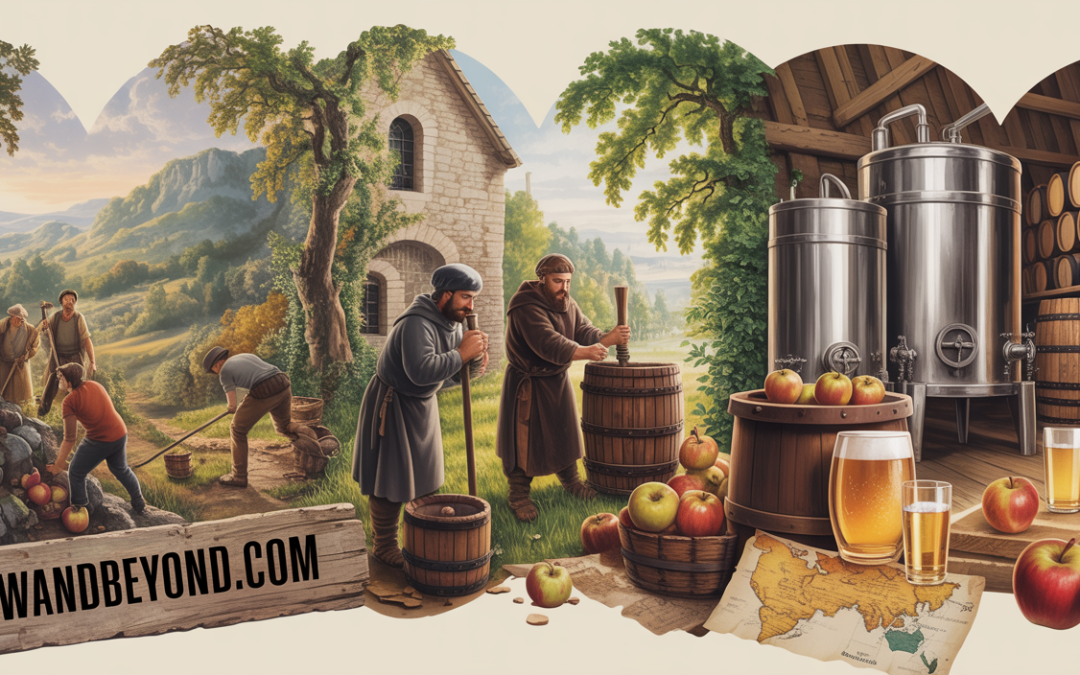Step back in time and embark on a fascinating journey through history as we uncover the evolution of cider, from ancient apples to the modern sips we enjoy today. Discover the roots of this beloved beverage and how it has evolved over centuries, capturing the essence of different cultures and traditions along the way. Delve into the rich heritage of cider production, from its humble beginnings to its current status as a global phenomenon. Prepare to be captivated by the story of cider’s journey through time, as we explore the intriguing tales behind this timeless apple elixir.
Ancient Apples
Cider-making has a long and fascinating history that dates back thousands of years. The origins of cider-making can be traced back to ancient cultures, where apples were cultivated and fermented to create a refreshing and intoxicating beverage. Ancient civilizations such as the Egyptians, Greeks, and Romans were known to produce cider, which they considered a valuable and enjoyable addition to their diets.
The Origins of Cider-making
The true origins of cider-making remain debated among historians. While apples were first domesticated in Central Asia around 4000–3000 BCE, there is no clear evidence that ancient Mesopotamia produced anything like modern cider. Instead, apple cultivation spread westward over centuries. By the European Iron Age (approximately 800 BCE to 100 CE), evidence suggests that people in northern France and Britain were making early fermented apple drinks. Classical sources mention apple beverages, but detailed descriptions of fermentation are sparse, indicating that what we now recognize as cider took clearer form in medieval Europe.
Early Cider Varieties
In addition to the Mesopotamians, while apples were cultivated in parts of the ancient Mediterranean, evidence of cider-making there is sparse. True cider-making traditions developed later in Europe.. They cultivated several varieties of apples, including the famous “sweet apple,” which was highly prized for its unique flavor and suitability for cider production. The Greeks and Romans also embraced cider-making, with the Romans in particular spreading the knowledge of apple cultivation and cider production throughout their empire.
Cider in Ancient Cultures
Cider held a prominent place in the cultures of ancient civilizations. It was not only enjoyed as a beverage, but it also had important symbolic and religious significance. In ancient Greece, for example, cider was associated with the goddess Pomona, who was considered the guardian of fruit trees. The Romans also had a deep appreciation for cider, associating it with the god Bacchus, the god of wine and celebrations.
Medieval Cider Production
The Middle Ages marked a period of significant development and expansion in cider production throughout Europe. Cider-making techniques became more refined, and the popularity of cider as a staple beverage grew among all social classes.
Cider-Making Techniques in the Middle Ages
During the Middle Ages, cider-making techniques underwent significant advancements. The use of mills and presses allowed for more efficient apple crushing and juice extraction, resulting in higher-quality cider. The addition of yeast to initiate fermentation and control the flavor profile further enhanced the taste of the cider. These techniques laid the foundation for the modern methods of cider production that we still use today.
Cider as a Staple Beverage
Cider became an integral part of the medieval diet, particularly in regions where apple cultivation thrived, such as Normandy in France and the West Country of England. It was consumed by people of all ages and social classes, acting as a reliable and safe alternative to potentially contaminated water. The availability of apples and the ease of producing cider made it an essential beverage in medieval Europe.
The Role of Monasteries in Cider Production
Monasteries played a significant role in the production of cider during the Middle Ages. They were skilled cultivators of apple orchards and possessed the knowledge and resources to produce high-quality cider. Monks carefully tended to their apple trees, selecting specific varieties known for their cider-making qualities. The cider produced in monasteries not only served as a dietary staple but also as a source of revenue for the monastic communities.
European Expansion
The European expansion during the Age of Exploration brought cider to the New World and further spread its popularity throughout Europe.
Cider in the New World
With the arrival of European settlers in the New World, cider-making techniques and apple cultivation were introduced to North America. The colonists brought with them apple seeds and knowledge of cider production, establishing orchards and cider mills across the continent. Cider quickly became a favored beverage among the early American settlers, and its production thrived in colonial America.
The Spread of Cider in Europe
As European powers expanded their territories, they introduced cider-making to new regions around the world. In particular, the Normans, who conquered England in the 11th century, brought their cider-making expertise with them. Cider production spread throughout England, Wales, and Ireland, becoming deeply ingrained in their cultures. Similarly, the Spanish and Portuguese introduced cider to their colonies in South America and the Caribbean.
Cider in Colonial America
Cider played a vital role in the daily lives of the early American colonists. It was regularly consumed by both adults and children, and its production became an important part of colonial agriculture. Apples were readily grown in the New World, and as a result, cider became a staple beverage in the American diet. It was consumed for sustenance, refreshment, and even as a form of currency among communities.
The Industrial Revolution
The Industrial Revolution in the 18th and 19th centuries brought significant advancements in technology and transportation, revolutionizing cider production and distribution.
Technological Advances in Cider Production
The Industrial Revolution introduced new machinery and techniques that greatly improved cider production. Mills and presses were mechanized, allowing for larger-scale production and increased efficiency. The use of steam power also replaced manual labor, further streamlining the cider-making process. These technological advancements enabled cider to be produced on a larger scale and made it more accessible to a wider audience.
The Rise of Commercial Cider
The Industrial Revolution sparked the rise of commercial cider production. In addition to traditional farmhouse cider production, large-scale commercial cideries emerged, producing cider for mass consumption. These commercial operations utilized modern production methods and were able to reach a wider market through improved transportation networks. The rise of commercial cider played a significant role in popularizing and commodifying cider as a commercial beverage.
Cider in the 19th Century
The 19th century saw cider’s popularity continue to rise, with innovations in storage and transportation contributing to its widespread availability. The development of pasteurization techniques allowed cider to be safely stored for longer periods, making it more accessible to consumers outside of the apple-growing regions. Moreover, the expansion of railroads facilitated the distribution of cider across vast distances, allowing consumers to enjoy cider from different regions.
Cider Prohibition
The early 20th century brought about a challenging period for cider production, with the rise of the temperance movement and the subsequent era of Prohibition.
The Temperance Movement
The temperance movement gained momentum in the late 19th and early 20th centuries, advocating for the reduction or elimination of alcohol consumption. Proponents of the movement believed that alcohol was a social evil and campaigned for stricter regulations on the production and sale of alcoholic beverages, including cider. The temperance movement set the stage for the eventual enactment of Prohibition in the United States.
Prohibition and the Decline of Cider
Prohibition, which lasted from 1920 to 1933, dealt a severe blow to the cider industry in the United States. The production and sale of alcoholic beverages were illegal, leading to the closure of many cideries and the destruction of orchards. Cider production was driven underground, and the quality of the cider suffered as amateur production methods prevailed. The decline of cider during Prohibition resulted in a loss of knowledge and skills that took years to recover.
Surviving Prohibition: Cider and Apple Orchards
While Prohibition had a devastating impact on the cider industry, some orchards managed to survive by converting their apple crops into non-alcoholic products, such as apple juice and cider vinegar. These orchards were able to weather the storm and preserve their apple tree heritage, ensuring the continuation of cider production once the government repealed Prohibition.
Revival of Cider
In recent decades, there has been a resurgence of interest in traditional cider-making and the revival of old apple varieties. Craft cider and the artisanal movement have breathed new life into the cider industry, elevating it to a realm of culinary artistry.
Craft Cider and the Artisanal Movement
Craft cider has emerged as a significant player within the beverage industry, offering consumers a wide range of unique and boutique ciders. Craft cideries focus on using traditional cider-making techniques, often utilizing heirloom apple varieties. These artisanal producers prioritize quality and flavor, crafting ciders that exhibit the complexity and distinctiveness of different apple varieties and fermentation processes.
The Resurgence of Traditional Cider-making
The resurgence of traditional cider-making has brought back heritage apple varieties that were once on the brink of extinction. Orchards across the globe are dedicated to preserving and cultivating these ancient apple varieties, ensuring their availability for future cider production. By rediscovering and reviving these historical apple varieties, cider makers are able to recreate authentic and diverse flavor profiles in their ciders, contributing to the preservation of cider-making traditions.
Cider’s Modern Image
In recent years, cider has shed its image as a solely traditional and rustic beverage and has embraced a more modern and sophisticated identity. With innovative flavor combinations and creative marketing approaches, cider has become an appealing choice for a wide range of consumers. It is now seen as a refreshing alternative to other alcoholic beverages, capturing the attention of beer and wine drinkers alike.
Global Cider Culture
Cider has become an integral part of the cultural heritage of many regions around the world. Different countries and communities have their own unique traditions, flavors, and celebrations associated with cider.
Cider Traditions Around the World
Cider traditions vary significantly across different countries and regions. In countries like France and Spain, where cider has a long history, specific regions have distinct cider-making traditions. For example, in Asturias, Spain, cider is typically poured from a height to aerate and enhance its flavor. In Normandy, France, cider is traditionally made from a blend of different apple varieties, resulting in a complex and well-balanced cider.
Regional Variations and Flavor Profiles
Cider exhibits a wide range of flavors and characteristics influenced by the apples, climate, and cider-making techniques of each region. In regions with colder climates, such as northern Europe and parts of North America, ciders tend to be crisp, acidic, and often effervescent. In contrast, ciders from regions with warmer climates, like Spain and parts of Australia, tend to be sweeter and have a richer flavor profile.
Cider Festivals and Celebrations
Cider festivals and celebrations are held in many countries, providing a platform for cider enthusiasts to come together and celebrate this beloved beverage. In Asturias, Spain, the annual “Festival de la Sidra” attracts thousands of visitors who gather to enjoy cider pouring competitions and traditional Asturian cuisine. The “Great Lakes Cider and Perry Festival” in the United States showcases regional ciders and offers educational workshops to promote cider appreciation.
Cider and Apple Heritage
Cider is deeply entwined with the heritage of apple varieties, highlighting the importance of preserving biodiversity for the future of cider-making.
Preserving Ancient Apple Varieties
Historically, thousands of apple varieties existed, each with its own unique characteristics and flavors. However, with the rise of modern agriculture, many of these apple varieties have become rare or even extinct. The cider industry plays a crucial role in preserving and protecting these ancient apple varieties by cultivating and utilizing them in the production of distinctive ciders. Preserving these apple varieties ensures that future cider-makers can continue to create diverse and flavorful ciders.
The Importance of Biodiversity in Cider-making
Biodiversity is essential for the long-term sustainability of cider production. Different apple varieties contribute to the complexity and depth of flavors found in ciders. Maintaining a diverse range of apple varieties helps to safeguard against disease and climate changes that may impact apple orchards. Additionally, biodiversity ensures that cider-makers have access to a wide range of apples with varying characteristics, allowing for the creation of diverse and unique cider blends.
Conservation Efforts
Various organizations and orchards are actively involved in preserving and conserving ancient apple varieties. These efforts include cataloging and documenting apple varieties, establishing orchards dedicated to rare and heritage apples, and promoting the conservation of apple biodiversity. By raising awareness and advocating for the value of these apple varieties, cider enthusiasts and organizations are ensuring that future generations can continue to enjoy the flavors and history of traditional cider.
The Science of Cider
Behind the artistry of cider-making lies the science that transforms apples into the delicious and complex beverage we know and love.
Fermentation: From Apples to Alcohol
Fermentation is a crucial process in cider-making that transforms apple juice into the alcoholic beverage we recognize as cider. Yeast, naturally present on apple skins or added specifically for fermentation, consumes the sugars in the apple juice and converts them into alcohol and carbon dioxide. The length of fermentation and the selection of yeast strains greatly influence the final flavor profile of the cider, contributing to its unique characteristics.
The Role of Yeast and Fermentation Processes
Different yeast strains impart distinct flavors and aromas to cider. Some yeast strains produce clean and neutral flavors, allowing the apple characteristics to shine, while others contribute fruity or spicy notes. Moreover, the fermentation process itself can be controlled to enhance specific flavor components, such as malolactic fermentation, which converts malic acid to lactic acid, resulting in a smoother and less tart cider. The skillful selection of yeast and fermentation techniques greatly contributes to the complexity and quality of cider.
The Chemistry and Taste of Cider
The chemistry of cider is a fascinating subject that affects both its taste and aroma. The composition of cider, including its sugar, acid, tannin, and alcohol content, influences its sweetness, tartness, and overall balance. The interaction between various compounds during fermentation and aging can result in a wide range of flavors, from bright and fruity to complex and earthy. Understanding the chemical processes that occur during cider-making is essential for creating ciders with the desired taste and characteristics.
The Future of Cider
The cider industry is experiencing a resurgence, with an increasing popularity and evolving consumer preferences. As the industry looks ahead, there are promising opportunities for growth and innovation.
Cider’s Growing Popularity
Cider’s popularity has soared in recent years, fueled by the craft beverage movement and an increasing consumer interest in locally sourced and artisanal products. Cider’s versatility and wide range of flavors attract a diverse consumer base, appealing to both traditional cider enthusiasts and those new to the beverage. The growing popularity of cider indicates a bright future for the industry, with new opportunities for cider makers to explore.
Innovation and Trends in Cider-making
The cider industry is witnessing a wave of innovation and experimentation. Cider makers are finding inspiration in the beer and wine industries, exploring unique flavor combinations, barrel aging, and even incorporating non-traditional ingredients. The use of wild fermentation techniques and natural cider-making processes is also gaining traction, creating ciders with complex and distinct flavors. By pushing the boundaries of traditional cider-making, cider makers are continually expanding the possibilities within the industry.
Sustainability in the Cider Industry
As the importance of sustainability becomes increasingly recognized, the cider industry is embracing eco-friendly practices. From adopting organic and regenerative farming methods to reducing waste and carbon emissions, cider makers are committed to minimizing their environmental impact. Additionally, the focus on preserving apple biodiversity contributes to conservation efforts and ensures the long-term sustainability of cider production. The industry’s dedication to sustainability positions cider as a beverage that not only delights the palate but also cares for the planet.
From its ancient origins to its modern resurgence, the journey of cider through history is nothing short of fascinating. As you savor a glass of your favorite cider today, take a moment to appreciate the centuries of tradition, innovation, and passion that have shaped this beloved beverage. Cheers to the past, present, and future of cider!
© 2025 by brewandbeyond.com. All rights reserved. No part of this document may be reproduced or transmitted in any form or by any means, electronic, mechanical, photocopying, recording, or otherwise, without prior written permission of brewandbeyond.com.




